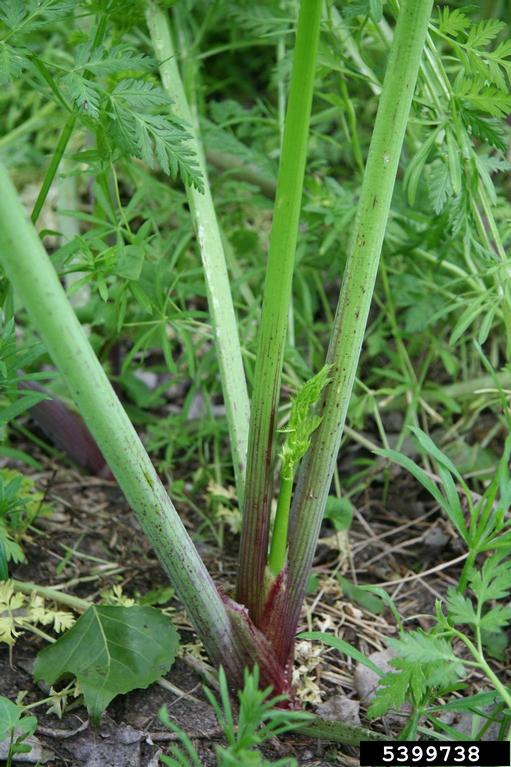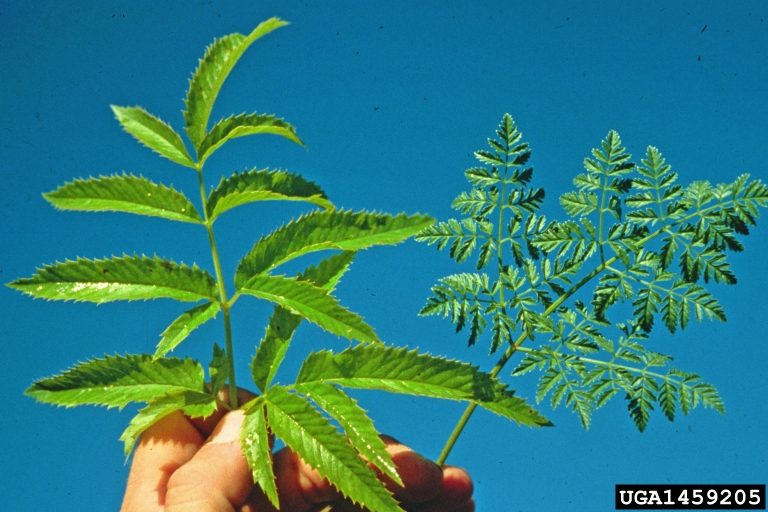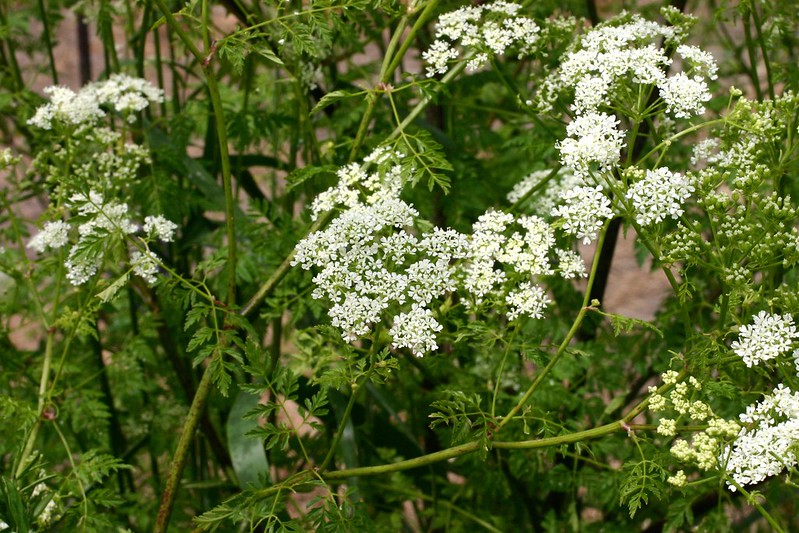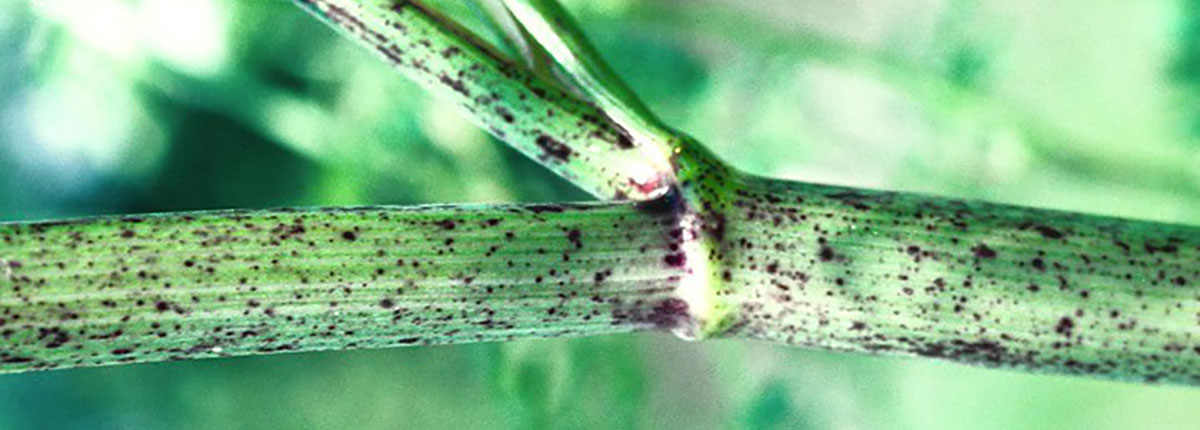How are we doing?
The Hort Update team strives to provide horticulture professionals with timely, relevant information from research-based sources. Complete a short survey and let us know how we can make Hort Update even better. Your feedback is greatly appreciated! Survey
| Serious Concerns | Major Symptom: |
|---|---|
| 1. Poison hemlock | Control and disposal |
| 2. March 31st growing degree days (GDD) | Several Nebraska sites below, Understanding Growing Degree Days |
| 3. Pest update | Pests to watch for based on growing degree days (GDD) |
| Research You Can Use | |
|
New this year, we'll be sharing practical research articles on topics of relevance to professional landscape managers. |
Keywords: |
| 4. Weed Control and Turf Safety of Single and Sequential Applications of Herbicides Over Spring SeedingsImproving Garden Soils with Organic Matter | Weed control during spring seeding |
| Greener Landscapes - Conservation & Climate Change Mitigation in Action | |
| Also new this year, practical information on improving your client landscapes' impact on climate change, habitat for native insects and other ecosystem services. | Application: |
| 5. Improving Garden Soils with Organic Matter | Simple tips for clientele on soil management |
| Timely Topics | |
| 6. Mitigating wildfire hazard | Guidelines for landscape development & management |
| 7. Desiccation of evergreens | Brown needles/foliage; dead twigs/branches |
| 8. Early spring pesticide applications | Common April tree pest control applications |
| 9. Winter annual weed control | Post emergent weed control now will not provide long-term control |
| Heads Up: For Your Information | |
| 10. ProHort Lawn & Landscape Update | Final spring program - April 4, virtual |
| 11. ProHort Lawn & Landscape Update - Fall virtual program | Recorded program available Go.unl.edu/prohort; cost $20.00 |
| 12. Commercial/Non-commercial pesticide applicator certification | Obtaining a new license or updating an expired license |
| 13. Digital Diagnostic Network - Need help with diagnostics? | Submit pictures and questions for diagnosis by Nebraska Extension experts |
Nebraska's drought status, 3/21/24 Map updated weekly.

1. Poison hemlockControl and disposal
 In recent years, social media has fueled concern among home gardeners about poison hemlock, Conium maculatum, also known as poison parsley. Poison hemlock is native to Europe, northern Africa and western Asia. It was introduced to North America in the 1800s as a garden ornamental and marketed as a "winter fern". It is now naturalized throughout most of North American, including the entire state of Nebraska, often found along roadsides or in unmanaged areas such fence lines, windbreaks or field edges. It prefers shaded moist areas and does not tolerate mowing well, which can be used to aid in control.
In recent years, social media has fueled concern among home gardeners about poison hemlock, Conium maculatum, also known as poison parsley. Poison hemlock is native to Europe, northern Africa and western Asia. It was introduced to North America in the 1800s as a garden ornamental and marketed as a "winter fern". It is now naturalized throughout most of North American, including the entire state of Nebraska, often found along roadsides or in unmanaged areas such fence lines, windbreaks or field edges. It prefers shaded moist areas and does not tolerate mowing well, which can be used to aid in control.
The plant is infamously reputed to have been the cause of Greek philosopher Socrates death, his chosen poison when sentenced to execution under Athens law. All parts of the plant are toxic, containing several closely related pyridine alkaloids – naturally occurring organic compounds found in some plants - but common sense precautions when handling and removing plants is all that's needed to prevent skin irrigation.
Image right - young poison hemlock plant with only slight red-purple markings on the stem. Robert Vidéki, Doronicum Kft., Bugwood.org.
 Lifecycle
Lifecycle
Poison hemlock is a biennial, germinating from seed in spring and throughout summer. First year plants are short, growing into a small bushy rosette of fern-like foliage. The following year, plants begin sending up a flower stalk in late April/early May which can reach up to 6-10 feet in height. Flowers consist of large flat clusters of many tiny white flowers, blooming in June and July. In fall of the second year, the plant's taproot dies along with the foliage after seed production is complete. Reproduction is only via seed.
Identification
Leaves have alternate arrangement on stems, although they may be oppositely arranged on the upper stems. The foliage is bright glossy green and finely divided (bipinnately compound) similar to carrot foliage. Leaves are smooth and hairless. On the lower leaves, petioles are long and their bases wrap around the main stem. Upper petioles are shorter and may not sheath the stem. Image above right - water hemlock foliage (far left) compared to poison hemlock foliage (far left). Steve Dewey, Utah State University, Bugwood.org
Three main identification characteristics – stems are hairless, hollow between nodes, highly branched, with reddish-purple streaks or splotches. Stem coloration is often very faint in young first year plants, so inspect non-blooming plants carefully.
 Blooms are composed of many clusters of tiny 5-petalled white flowers, creating showy flat-topped flower heads.
Blooms are composed of many clusters of tiny 5-petalled white flowers, creating showy flat-topped flower heads.
Look A-likes
- Queen Anne's lace, aka wild carrot (Daucus carota) – no purple mottling on stems; usually 3 feet or less in height; white hairs on stems; blooms from June through September
- Wild parsnip (Pastinaca sativa) – no purple mottling on stems; stout grooved stems; yellow flowers; blooms May to July
- Water hemlock (Cicuta maculata) – does have purple mottling and hollow, hairless stems, but foliage is much coarser and not fern-like; also, unlike poison hemlock, has a cluster of fleshy taproots at the base of the plant; blooms July to September.
Image left - Poison hemlock flowers by Oregon Department of Agriculture, CC BY 2.0.
Toxicity
All plant parts are toxic; dead canes can remain toxic for up to three years. Mature seeds are the most poisonous. Eating plant parts is the main danger to both humans and livestock, but sap can cause skin rashes and toxins can be inhaled affecting the respiratory system.
Control
Use the same precautious when working with poison hemlock, that would be used with poison ivy. A simple touch to a stem or flower won't kill you, but sap on your skin could give you a rash. People with a history of severe allergic reactions should be especially careful. Always protect yourself by wearing chemical resistant gloves, long sleeved shirt, long pants, shoes and socks. Small infestations can be pulled by hand or removed with a shovel. Large infestations can be cut down with a string trimmer. Be careful when using and cleaning equipment to keep sap off your skin.
Plant debris should be bagged, the bag tied closed and disposed of in the trash. Or pit compost plant debris by digging a deep hole and burying plants where they will not be disturbed or seeds able to germinate.
- Don't burn dead plant material as toxins can become airborne.
- Don't add plant debris to a compost pile.
- Don't leave plant debris where children or livestock have access to it.
Herbicide applications are most effective on 1) young seedlings, 2) in fall when 1st year plants are in the rosette stage or 3) in early spring on 2nd year plants before flower stalk development begins. Do not use herbicides on large mature plants; instead cut of the flowers to prevent seed development, mow large plants down and use herbicides to kill the first-year plants. Keep children and livestock away from areas where plant debris is left on the ground.
Selective broadleaf herbicides
- Residential landscapes – 2,4-D, dicamba, triclopyr
- Livestock producers – 2,4-D ester + dicamba, Grazon P+D (picloram + 2,4-D), Streamline (aminocyclopyrachlor + metsulfuron)
In addition to the products above, the non-selective herbicide glyphosate (RoundUp) is also effective but should be used carefully to minimize damage to turfgrass or other desirable ornamental plants.
Legal Status in Nebraska
Poison hemlock does not have noxious weed status and is not a legally regulated plant in Nebraska. Plants or infestations do not need to be reported. Control is not required but is encouraged.
References
Lingenfelter, D., & Graybill, J. S. (2022, June 12). Poison Hemlock: Facts About this Early Season Weed. Penn State Extension. Retrieved June 28, 2022, from https://extension.psu.edu/poison-hemlock-facts-about-this-early-season-weed
Poison-hemlock identification and control: Conium maculatum - King County. (2019, January 19). King County, Washington State. Retrieved June 28, 2022, from https://kingcounty.gov/services/environment/animals-and-plants/noxious-weeds/weed-identification/poison-hemlock.aspx
Reeves, K. (2010). Exotic Species: Poison Hemlock. National Park Service. Retrieved June 28, 2022, from https://bit.ly/24-hemlock
Stubbendieck, J. L. (2003). Weeds of the Great Plains. In Poison hemlock (3rd ed., pp. 44–45). Nebraska Department of Agriculture.
2. March 28th growing degree days (GGD)
| Location | Accumulated Growing Degree Days |
|---|---|
| Grand Island, NE - Airport | 30 |
| Lincoln, NE - Airport | 39 |
| Omaha, NE - Airport | 32 |
| Norfolk, NE - Airport | 20 |
| North Platte, NE - Airport | 3 |
| Scottsbluff, NE - Airport | 4 |
3. Pest updatePests to watch for based on Growing Degree Days (GDD)
| GGD (base 50) | Insect | Lifestage present at this GGD |
|---|---|---|
| 25-100 | Zimmerman pine moth | 1st larvae |
| 45-100 | Eastern tent caterpillar | Egg hatch |
| 150 | Eastern tent caterpillar | Tents apparent |
| 100-195 | European pine sawfly | 1st larve |
| 150-175 | Spruce spider mite | 1st egg hatch |
| 220-250 | Honeylocust spider mite | Egg hatch |
| 245-440 | American plum borer | Adult flight and egg laying |
| 250 | Codling moth | 1st generation control stage |
| 400-500 | Emerald ash borer (peak adult emergence at 1000-2000, see below) | 1st adult emergence |
| 400-575 | Euonymous scale | 1st generation |
| 400-600 | Bronze birch borer | Adults, eggs, new larvae |
| 440-700 | Ash sawfly | 1st larvae appear |
| 600-900 | Bagworm | Larvae appear |
For a more complete list, visit Michigan State University GGD of Landscape Insects or GGD of Conifer Insects.
4. Weed Control and Turf Safety of Single and Sequential Applications of Herbicides Over Spring SeedingsWeed control during spring seeding
Weed control is important during establishment of cool-season grasses, especially when seeded in spring near summer annual weed germination. Siduron has been the industry standard due to its safety (low level of herbicide injury) to seedlings of cool-season grasses and adequate control of warm-season summer annual grassy weeds. However, Siduron only has short-term residual control and requires repeat applications for season-long control. There are other labeled herbicides, e.g. Mesotrione, Qinclorac, with turf safety when applied shortly before and after seeding.
See Weed Control and Turf Safety of Single and Sequential Applications of Herbicides Over Spring Seedings for information on the these newer herbicides, from the University of Nebraska-Lincoln.
5. Improving Garden Soils with Organic MatterSimple tips for clientele on soil management
Although soil health is critical to plant growth, client questions about soil are uncommon. Soil seems to be considered only when there is a plant problem. We might hear “I can’t figure out what’s wrong with my plant, so there must be a soil problem”. If asked what soil management practices are used, the answer is often little to none. Encourage clients to focus on soil as part of garden and landscape practices for healthy plant growth and efficient use of resources like water.
Important goals for soil management are increasing organic matter, avoiding or relieving compaction, improving drainage or water holding capacity, and encouraging a healthy soil ecosystem. Increasing soil organic matter is one practice used to achieve these goals. On soil tests, the organic matter percentage is recommended to be 5 percent. When tested, the percentage is often around 1 to 2 percent.
Because organic matter breaks down, encourage annual application in vegetable gardens and annual flower beds, and prior to installing new lawns and landscape beds. In established lawns, organic matter may be gradually increased by leaving grass clippings while mowing and spreading and raking compost into holes after core aeration. In established landscape beds, use compost as a mulch or spread one inch over bare soil and then cover it with a coarse organic mulch like arborist wood chips.
Improving Garden Soils with Organic Matter, Oklahoma State University
6. Mitigating wildfire hazardGuidelines for landscape development & management
Nebraska has been at high risk for wildfires due to current weather conditions. One way to mitigate fire hazard is reducing “fuel” within 5 feet of a home’s foundation. For example, the dry, dead tops of ornamental grasses create fuel for a carelessly discarded cigarette or electrical short. They ignite easily, burn rapidly and flames can reach quite high. Cut or mow grasses low near a house, garage, outbuilding, deck, firewood pile, propane tank, shrub, and specimen trees with low-growing branches. Other things to avoid or remove when conditions for wildfire are high include:
- Climbing plants against buildings
- Branches within 10 feet of chimney
- Litter in roof gutters
- Combustibles items under decks or near homes
- Combustible containers, mulch (rubber mulch ignites the easiest and is most difficult to extinguish), fencing, furniture and firewood
Living with Fire: A Homeowner's Guide, Nebraska Forest Service
7. Desiccation of evergreensBrown needles/foliage; dead twigs/branches
Conditions remain dry and time will tell how much dessication injury we will see on plants. When injury shows up, remind clients to wait to prune damaged plant tissue until about June 1. Waiting allows new growth to occur if buds are still viable. If no new growth occurs on evergreens by June 1, and the damage is severe enough the plant has to be pruned back beyond where there is green foliage, evergreens will not regenerate new growth from this point. It would be best to replace the plant.
8. Early spring pesticide applicationsCommon April tree pest control applications
For chemical pest control, application timing is as important as selecting the correct pesticide. Homeowners often want an application once they observe plant symptoms or signs of a pest and this is often not an effective application time; resulting in an unnecessary use of a pesticide and increased risk of pesticide resistance. While applications based on plant developmental or on growing degree days is best, the following pest problems are typically controlled in April, especially if a plant had a history of unacceptable damage the previous season.
- Spruce mite – when active mites are detected on the tree (use white paper test)
- Diplodia tip blight of pines - about the 3rd week of April
- Fireblight on apple, crabapple and other trees and shrubs - when 25% of flowers are open
- Apple scab, cedar apple rust and ornamental pear rust – just after leaf buds open
- Zimmerman pine moth – early April
9. Winter annual weed controlPost emergent weed control now will not provide long-term control
The purple blooms of henbit are coloring fields and home landscapes; soon to come - the tiny blue flowers of field speedwell and lush green blades of annual bluegrass. All these weeds are winter annuals, meaning they germinated last fall and the small plants overwinter to grow aggressively in early spring with blooming in April to May. They die with hot, dry weather in mid to late June, but seed production can be high in spring and is one reason infestations worsen each year.
Control of winter annual weeds with post emergent herbicides at this time of year is not very effective. Plants will die soon on their own. The best option at this time is to hand pull if feasible to allow turfgrass to fill in areas and minimize seed production. If winter annual infestations are unacceptable, apply a preemergent herbicide in late summer to early fall. Other management options include maintaining a vigorously growing lawn to compete with annuals; or using a 2 to 3-inch layer of mulch in landscape beds to reduce seed germination.
12. Commercial/Non-commercial pesticide applicatorsObtaining a new license or updating an expired license
If you have a pesticide applicators license which expired in April 2024 or you need to get a new license, commercial/noncommercial applicators have several options to recertify or get a new license.
2024 Traditional Classroom Training
Commercial/non-commercial in-person training classes are held from January through April. Training schedules will be available soon at https://pested.unl.edu/. In-person trainings are a supplemental learning opportunity; they DO NOT replace pre-class studying of category manuals or flipcharts for test preparation. Study materials for all commercial categories must be purchased online https://pested.unl.edu/
Testing-only Options
- Closed-book exams are given by the Nebraska Department of Agriculture (NDA). Preregistration is not required an there is no cost. Visit the link below for a list of available test-only dates, times and locations - https://pested.unl.edu/.
- NDA computer-based testing is provided through the Pearson-Vue company. Click here for a list of testing sites, categories available, dates, and registration information. Cost $55 per exam. (For applicators with multiple categories on their license, each category is charged the full testing fee.)
Commercial/noncommercial applicators are professionals who apply restricted-use pesticides for hire or compensation. Anyone who applies pesticides to the property of another person, either restricted- or general-use products, for control of pests in lawns, landscapes, buildings or homes must also have a commercial pesticide applicators license. Public employees (those employed by a town, county, state) applying mosquito control pesticides whether restricted- or general-use, must also hold a commercial or noncommercial certification.
13. Digital Diagnostic Network - Need help with diagnostics?Submit pictures and questions for diagnosis by Nebraska Extension experts
Do you or your clients have questions you need help answering? Maybe you are a lawn care person and they're asking about trees, shrubs, or flowers? While you can refer them to their local Extension office, another option is Digital Diagnostic Network. Homeowners, lawn care professionals, pest control operators and others are invited to submit questions and photos through this website or with the assistance from an Extension professional at any Nebraska Extension office. All offices are equipped with high-resolution digital image capturing technology. Whether the question is about a lawn weed, insects on a plant, diseases in a shrub border or other, an expert panel of Extension professionals will review and respond to the question. To get started, create an account so the question can be reviewed and responded to via email. For more information and to create an account, go to Digital Diagnostic Network.
Bugging Out With Your Camera Phone - Tips on how to get a good picture.
Reference to commercial products or trade names is made with the understanding that no discrimination is intended and no endorsement by Nebraska Extension is implied. Use of commercial and trade names does not imply approval or constitue endorsement by Nebraskas Extension. Nor does it imply discrimination against other similar products.

